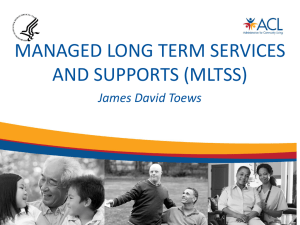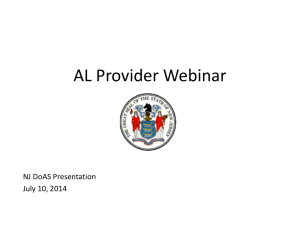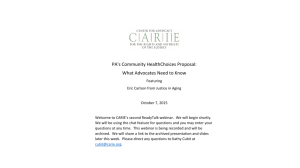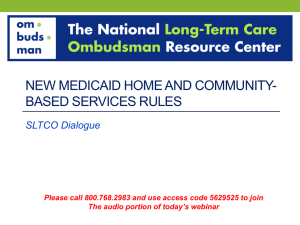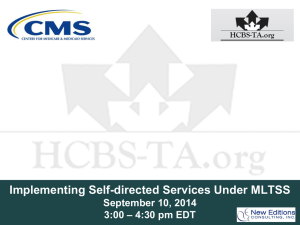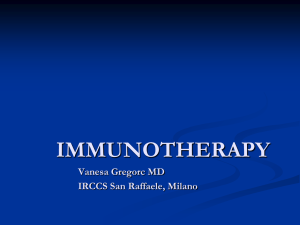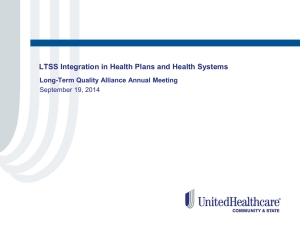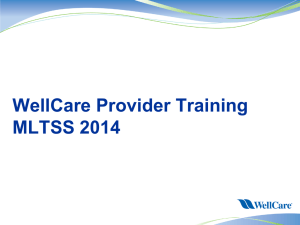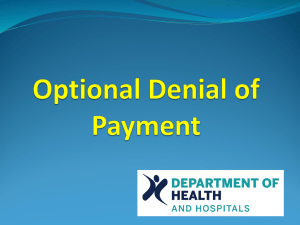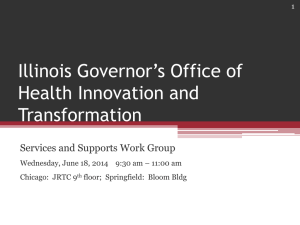Medicaid Transformation: Managed Care & Long
advertisement
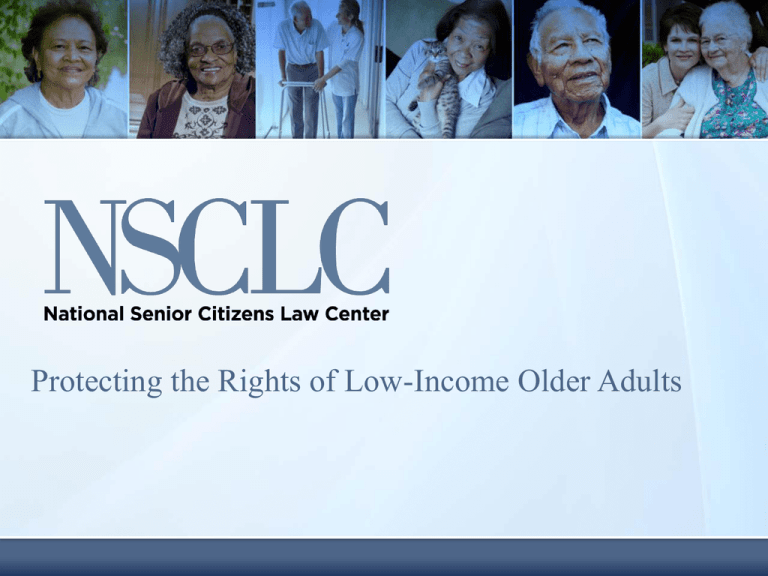
Protecting the Rights of Low-Income Older Adults January 23, 2014 Medicaid Transformation: Managed Care & Long Term Services and Supports Gwen Orlowski, National Senior Citizens Law Center www.NSCLC.org 2 The National Senior Citizens Law Center is a non-profit organization whose principal mission is to protect the rights of low-income older adults. Through advocacy, litigation, and the education and counseling of local advocates, we seek to ensure the health and economic security of those with limited income and resources, and access to the courts for all. For more information, visit our Web site at www.NSCLC.org. What will be covered • What are Medicaid Managed Long Term Services and Supports (MLTSS)? • Why are we talking about this now? What’s going on nationally? • How can advocates make a difference? – A focus on Service Plans/Plans of Care Assessments Grievances Case/Care Managers Prior Authorization Appealing Actions Fair Hearings Aid Paid Pending/Continued Benefits What are Managed Long Term Services and Supports • Managed care = delivery system for services • LTSS = institutional services and home and community-based services (HCBS) • Examples of HCBS: - case/care management home health aides personal care assistance chore services - respite adult day assisted living habilitation 5 Delivery System Transformations Transition from: Fee-for-Service (FFS) ↓ Transition to: Risk-based Managed Care Medicaid managed LTSS: LTSS through capitated care Fee for service LTSS CMS and State LTSS Provider Managed LTSS CMS and State LTSS* MCO Beneficiary DME DME* Beneficiary * If provider is part of network and service part of care plan www.NSCLC.org 7 Delivery System Transformations – New Populations • • • Aged/Duals Younger Adults with physical disabilities Individuals with Intellectual and Developmental Disabilities – New Services • • State Plan Carve Outs → Carved Back in (e.g., Personal Care & Adult Medical Day in NJ) Long Term Services and Supports (26 states as of 2014) Delivery System Transformations What factors are driving the shift? 1. Consumers want to receive services in HCBS 2. Medicaid expenditures for people who are aged and disabled, including those in nursing homes, are disproportionately high and growing 3. Managed care purportedly improves access to good quality care, while at the same time containing or stabilizing cost 4. Rebalancing – shifting dollars away from institutions toward HCBS Three initiatives driving rebalancing 1. Medicare-Medicaid financial alignment demonstrations (dual eligible demonstrations) 2. States shifting to managed care: – Medicaid managed long-term services and supports (MLTSS) through 1115, 1915(b) and 1915(c) waiver 3. States are pursuing innovative improvements to LTSS introduced in the Affordable Care Act: – Balancing Incentive Payment Program (BIPP) – Community First Choice Option 10 Growth of MLTSS in States • Number of States with MLTSS programs * → 8 states in 2004 → 16 states in 2012 → 26 projected by 2014 • MLTSS States as of 11/13**: AZ, CA, DE, FL, HI, IL, KS, MA, MI, MN, NC, NE, NH, NJ, NM, NY, OH, PA, TN, TX, WA, WI *The Growth of Managed Long-Term Services and Supports Programs: A 2012 Update – Truven Health Analytics/CMS (July 2012) **State Medicaid Integration Tracker, November 15, 2013, www.nasuad.org 11 Growth of MLTSS in States • # of individuals receiving LTSS through MCOs: * → 105,464 in 2004 → 389,390 in 2012 • As of 2012, approx. ½ of the states →mandatory enrollment • Corporate status, market share of members: – For Profit: 44% – Non-Profit: 32% – Public or Quasi-Public: 24% 12 Growth of MLTSS in States • Populations served: – Older Adults (CA, FL, MA, MN) – Older Adults and Adults with Physical Disabilities (AZ, DE, HI, NM, NY, TN, TX, WA, WI) – States which include Adults with ID/DD (AZ, HI, MI, NC, PA, WA, WI) • As of 2012, 8 states offered self-directed options (AX, DE, HI, MA, MN, TN, TX, WA)(KS’s 1/1/14 date was delayed by CMS) 13 MLTSS Info Source #1: CMS Guidance • 10 Elements in May, 2013 CMS guidance: Planning Strategies Beneficiary Support Stakeholder Engagement Person-centered Process Quality Enhanced HCBS Participant Protections Comprehensive Service Package Payment Alignment Qualified Providers 14 MLTSS Info Source #2: CMS Final Rule on Community Living Options • Choice of service provider. • Private Rooms, roommate choice, lease protections. • Heightened scrutiny for locations with qualities of an institutional setting. • Grandfathering to protect beneficiaries penalized by increased stringency of level of care (LOC) after modification. 15 MLTSS Info Source #2: Community Character • CMS proposed definition to community-character in 2012: – NSCLC Comments: http://www.nsclc.org/wpcontent/uploads/2012/07/comments-on-HCBSstate-plan-regs-NSCLC-7-2-12.pdf – LeadingAge Comments: http://www.leadingage.org/uploadedFiles/Content/ Members/HCBS/Home_Care_and_Home_Health/Le adingAge_Comments_on_Community_First_Choice _Option.pdf 16 Community character in MLTC waivers • New Jersey definition of community character of HCBS: – Private, semi-private bedrooms, bathrooms – Access to food at any time – Ability to make decisions about daily activities, including visitors and food – Privacy to visit with friends – Choice on how and when to spend time 17 Community character in Florida • Similar to New Jersey requirements • Differences include: – Resident may lock unit – Personal sleeping schedule – Choice of eating schedule Choice of length of telephone calls 18 Lessons Learned? Stories from the trenches of Kansas and NJ What happens when an individual’s services are reduced? Or terminated altogether? • In NJ, Mr. L was on the TBI waiver for more than 10 years, he was also HIV positive, had diabetes, and in 2009, had developed a seizure disorder. Since 2009, he has been assessed for and received 40 hours a week in personal care services. In November 2012, his new MCO reassessed Mr. L and determined that he needed on 8 hours per week of PCA services. Now what? 19 What to think about Assessment Process • Continuity of Care? • Service Plan/Plan of Care? • Who? Conflict-free? • Assessment tool • History of assessments – can you access old tools? • Care-managers role? • What is a Prior Authorization? Is the MCO decision an “action”? • Any “action” gives rise to Constitutionally protected due process rights • Grievance rights • Appeal rights • Rights to a state fair hearing • Aid paid pending/ Continued Benefits www.NSCLC.org 20 Where to begin? • What does the waiver say? • §1115 Special/Standard Terms and Conditions • §1915(c) waivers → cms.gov • Read the Contract • Care management; continuity of care; prior authorizations and utilization review; readiness reviews, network adequacy, grievances/appeals/state fair hearing rights; conflict free care management • Quality Data and Transparency 21 Contract Language: New Jersey Prior Authorization Prior Authorization Limitations: In no instance shall the contractor apply prior authorization requirements and utilization controls that effectively withhold or limit medically necessary services, or establish prior authorization requirements and utilization controls that would result in a reduced scope of benefits for any enrollee. Continuation of Benefits: The MCO shall continue benefits if: • • • • The enrollee/provider files the appeal timely; The appeal involves a service termination, suspension or reduction The services were ordered by an authorized provider If enrollee requests a FH, continues of benefits must be requested within 10 days of action letter or intended effective date, whichever is later 22 Contract Language: Kansas Prior Authorization In accordance with 42 CFR 438.420(b), the MCO must continue the Member’s benefits currently being received, including the benefit that is the subject of the appeal, if all of the following are met: • The Member or his or her representative files the appeal timely, meaning on or before the later of the following: within 10 days of the MCO mailing the notice of action or the intended effective date of the MCO proposed action; • The appeal involves the termination, suspension, or reduction of a previously authorized course of treatment; • The services were ordered by an authorized provider; • The original period covered by the authorization has not expired; and • The Member requests an extension of the benefits. 23 Persistence: • Systems Advocacy • Individual Advocacy 24 More info on MLTSS, Florida, NJ and NY waiver • NSCLC’s MLTSS page with resources from Eric Carlson: – Summary on MLTSS Guidance – Special report on Florida’s LTC Managed Care Program – Analysis of New York and New Jersey’s MLTSS Program Available at: www.nsclc.org/index.php/mltss 25 Contact: Gwen Orlowski, gorlowski@nsclc.org www.NSCLC.org 26
